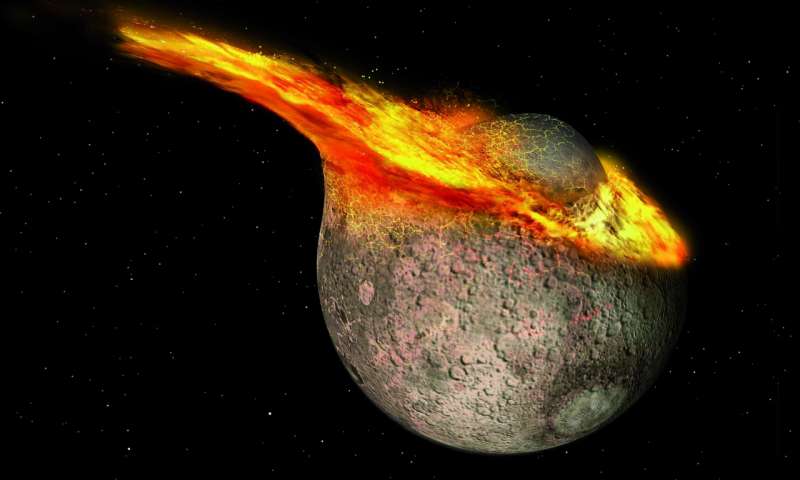The moon is 85 million years younger than previously thought

It turns out the moon is a little younger than scientists previously thought — about 85 million years younger, to be precise.
In a new study, researchers at the German Aerospace Center found out that, not only did the moon once have a massive, fiery magma ocean, but our rocky satellite also formed later than scientists previously expected.
Billions of years ago, a Mars-size protoplanet smashed into the young Earth and, amid the debris and cosmic rubble, a new rocky body formed — our moon. In this new work, the researchers reconstructed the timeline of the moon's formation. While scientists have previously thought that this moon-forming collision happened 4.51 billion years ago, the new work pegged the moon's birth at only 4.425 billion years ago.
Related: How the Moon formed: 5 wild lunar theories
To determine this 85-million-year error in the moon's age, the team used mathematical models to calculate the composition of the moon over time. Based on the idea that the moon was host to a massive magma ocean, the researchers calculated how the minerals that formed as the magma cooled solidified changed over time. By following the timeline of the magma ocean, the scientists were able to trace their way back to the moon's formation.
"By comparing the measured composition of the moon's rocks with the predicted composition of the magma ocean from our model, we were able to trace the evolution of the ocean back to its starting point, the time at which the moon was formed," study co-author Sabrina Schwinger, a researcher at the German Aerospace Center, said in a statement.
These findings, which show that the moon formed 4.425 billion years ago (give or take 25 million years), agree with previous research that aligned the moon's formation with the formation of Earth's metallic core, according to the statement.
Get the Space.com Newsletter
Breaking space news, the latest updates on rocket launches, skywatching events and more!
"This is the first time that the age of the moon can be directly linked to an event that occurred at the very end of the Earth's formation, namely the formation of the core," Thorsten Kleine, a professor at the Institute of Planetology at the University of Münster in Germany, said in the same statement.
These findings were described in a new study published on July 10 in the journal Science Advances.
Email Chelsea Gohd at cgohd@space.com or follow her on Twitter @chelsea_gohd. Follow us on Twitter @Spacedotcom and on Facebook.
Join our Space Forums to keep talking space on the latest missions, night sky and more! And if you have a news tip, correction or comment, let us know at: community@space.com.

Chelsea “Foxanne” Gohd joined Space.com in 2018 and is now a Senior Writer, writing about everything from climate change to planetary science and human spaceflight in both articles and on-camera in videos. With a degree in Public Health and biological sciences, Chelsea has written and worked for institutions including the American Museum of Natural History, Scientific American, Discover Magazine Blog, Astronomy Magazine and Live Science. When not writing, editing or filming something space-y, Chelsea "Foxanne" Gohd is writing music and performing as Foxanne, even launching a song to space in 2021 with Inspiration4. You can follow her on Twitter @chelsea_gohd and @foxannemusic.
-
rod Some discussion on this topic already too in the forums, see https://forums.space.com/threads/earths-moon-had-a-magma-ocean-for-200-million-years.32361/Reply
This new space.com article says "While scientists have previously thought that this moon-forming collision happened 4.51 billion years ago, the new work pegged the moon's birth at only 4.425 billion years ago."
The age for the origin of the solar system is established by the meteorite radiometric ages assigned, https://ui.adsabs.harvard.edu/abs/2010NatGe...3..637B/abstract, "The age of the Solar System can be defined as the time of formation of the first solid grains in the nebular disc surrounding the proto-Sun. This age is estimated by dating calcium-aluminium-rich inclusions in meteorites. These inclusions are considered as the earliest formed solids in the solar nebula. Their formation marks the beginning for several long- and short-lived radiogenic clocks that are used to precisely define the timescales of Solar System events, such as the formation and evolution of planetary bodies. Here we present the 207Pb-206Pb isotope systematics in a calcium-aluminium-rich inclusion from the Northwest Africa 2364 CV3-group chondritic meteorite, which indicate that the inclusion formed 4,568.2million years ago."
So this new age for the origin of the Moon is 1.43E+8 years later (the lunar magma ocean involved too), after the date assigned to the origin of the solar system, 4.568E+9 years old. It is important to reconcile various ages obtained from different samples, including lunar zircons and Earth zircons like the Jack Hills dated 4.375E+9 years old or 4.39E+9 years old.









